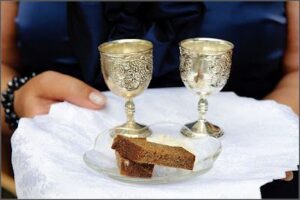German Wedding Traditions – The Hochzeitslader, the Polterabend and the Baumstamm Sägen
Maybe you met a handsome foreigner on your last trip to Bavaria and it’s blossomed into a full-fledged future together. Maybe you were cleaning the attic and uncovered a ribbon commemorating your great-grandmother’s prize-winning sauerkraut. Whether you’re seeking ways to impress your soon-to-be in-laws, or you want to honor your own family’s roots, including some traditional German customs in your wedding ceremony is a lovely way to mesh two cultures into one bright future.
The Hochzeitslader
What is Hochzeitslader? Simply said, a hochzeitslader ( Der Hochzeitslader ) is a formal wedding-inviter in the traditional german weddings. Read more here: Wedding Bitters
Before there was a reliable postal service, there was the Hochzeitslader. If you want to bring this old Bavarian custom to life, you’ll need to designate one special member of the wedding party as the Hochzeitslader. He (or she, if you’re being modern) will have the honor of personally visiting each invitee’s house to deliver the invitation–imagine the money you’ll save on stamps!
Far from merely handing over a card, the Hochzeitslader invites guests by reciting a made-up rhyme. As invitees accept, they take one of the many ribbons that’s pinned to the Hochzeitslader’s fancy outfit and pin it to the Hochzeitslader’s hat instead. Just think–there’ll be no waiting for tardy RSVPs!
While you probably won’t want to send your exhausted Hochzeitslader to visit each and every invitee (especially considering your out-of-town guests), you can still embrace the custom by sending a personal invitation to the folks who will most appreciate the gesture (i.e. the German side of the family). As is the Bavarian tradition, be prepared for the Hochzeitslader to be invited inside for a celebratory drink at each house he or she visits–you may want to designate a driver, as well.
Breaking China
Usually, a couple wants to avoid dropping breakable kitchenware the night before their wedding–not so at the Polterabend! During this party, the happy couple and their guests are encouraged to break as much china as possible, throwing it to the floor with enthusiasm. The loud noises will supposedly scare off evil spirits, and according to the custom, the dishes can break so the marriage never will. Afterward, the shards are swept away by the couple, showing how well they work as a team.
If you’re planning on throwing a Polterabend, be sure guests know not to bring glass or mirrors (the breaking of either is considered bad luck). Stick with traditional pottery and china, and make sure everyone wears shoes. You may wish to incorporate this ritual into the bachelor or bachelorette party–or at least keep it in mind if either of those parties get out-of-hand. That way, you can always claim you dropped the cheese platter on purpose.
Salt and Bread
Traditionally, German brides carry a little bit of salt and bread to ensure bountiful food, and German grooms carry grain for wealth and luck. While a few grains of rice can be slipped into the groom’s pocket fairly easily, the bride has a larger problem. If you’re not thrilled with the idea of cramming an entire loaf of rye into the folds of your wedding dress, you can symbolically “carry” the lucky ingredients by giving a toast with some salted bread at the reception.
Ransoming Your Exit
After the marriage ceremony, the newlywed couple heads toward the exit but cannot leave. The crowd has blocked the exit with ropes of flowers and ribbons! (You may need to let your more rambunctious friends be in charge of this custom, since you can hardly rope in your own selves.) In order to win their way outside, the couple has to “bribe” their way through the barricade with promises of a lavish reception.
Sawing the Log
The marriage is official; now roll up your sleeves and get to work! Immediately following the ceremony comes the baumstamm sägen, with the newlywed couple emerging from their wedding venue to find a log presented on a sawhorse. It is then the couple’s task to each grasp one end of a saw (a two-man crosscut saw is probably your best bet) and cut the log together.
Sawing through the log is symbolic of the first hard task the marriage will have to confront, so you may want to practice your technique before doing it in front of a crowd. Not feeling the lumberjack spirit? If you don’t fancy the thought of perspiring through your makeup and getting sawdust stuck to your gown, you can opt for a thin, stick-like “log” instead of a whole tree.
A video is always better:
These are just a few festive customs that traditional German marriage ceremonies offer. Whether you opt for a full German wedding or you just want to add a few traditional touches, you’re guaranteed to enliven the proceedings and thrill your German guests. Your heritage makes you unique, so why not let it make your wedding unique as well?



